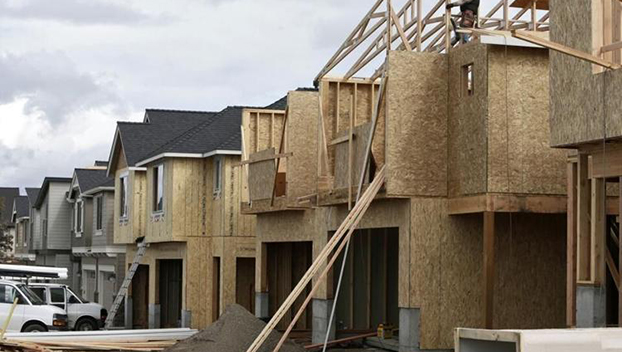Private Treaty February 2025
Pacific Cattle Angus, Sim-Angus, and Simmental range-raised production fall bulls available by PRIVATE TREATY FEBRUARY 2025 Carl Wisse • carl@pacificcattle.com www.pacificcattle.com • 509-539-6850 • Eltopia, WA
Published 8:32 am Thursday, January 23, 2025

Oregon has continued losing farm and forest land despite statewide agriculture protections, spurring lawmakers to consider tightening land use rules this year.
The debate recently kicked off in the Senate Natural Resources and Wildfire Committee, which will be reviewing several bills aimed at curbing development in protected zones.
In the half-century since Oregon adopted its land use system, the number of non-farm uses allowable in farm zones has multiplied from six to more than 60, according to the state’s Department of Land Conservation and Development.
The concern is that scattered development is degrading the landscape’s ability to support a healthy agricultural economy, similarly to how fragmentation deteriorates wildlife habitat, said Hilary Foote, DLCD’s farm and forest specialist.
The process amounts to a “shadow conversion” in which dispersed non-farm uses undermine the “critical mass” of farmland that’s needed to sustain the industry and ancillary businesses, said Jim Johnson, working lands policy director for 1000 Friends of Oregon, a farmland preservation group.
“You start to add these up and they have a real cumulative impact on agriculture,” said Johnson, formerly the land use and water planning coordinator for the Oregon Department of Agriculture. “The cumulative impact is not being considered because it’s being reviewed on a case-by-case basis.”
Farmland loss
The rate of farm and forest land loss in Oregon depends on how it’s measured: Since 1987, 43,000 acres have been removed from farm zoning and 10,000 acres have been removed from forest zoning, according to DLCD.
However, according to USDA, the amount of land in farm use has declined by 2.4 million acres between 1997 and 2022. That number is larger because USDA sets a low bar for what’s considered farmland, so the reduction likely includes many smaller parcels that were developed within urban growth boundaries, Foote said.
The most recent USDA Census of Agriculture shows Oregon as losing 666,500 acres in the five years preceding 2022, or about 4.2% — higher than California’s loss of 1.4%, said Johnson. “That’s really started to raise some red flags for me.”
Energy projects have contributed to the losses, with solar facilities permitted on about 33,000 acres of farmland over the past 15 years, said Foote. Given the projects currently in the pipeline, that acreage could soon increase another 40,000 acres.
Large projects come under the purview of the state’s Energy Facility Siting Council, which “has not denied a single solar facility,” said Johnson.
Preventing losses
The Senate Natural Resources and Wildfire Committee will be considering several ways to prevent farm and forest land losses, including:
New income streams
Some members of the committee pushed back against the notion that agritourism and solar development pose a threat to farming.
During times of low prices and natural disasters, growers who diversify to generate other income streams can avoid becoming unprofitable, said Sen. Todd Nash, R-Athena.
“How do these guys get through those years if they can’t do these other types of things?” he said.
Sen. Kathleen Taylor, D-Portland, said she perceived “kind of this attack on solar,” which can be deployed on marginal land by farmers who continue cultivating more productive parcels.
“I don’t know that it’s all in the negative category,” she said. “I don’t want the committee to be led to believe anyone can put a solar farm anywhere they want in the state.”
Dave Hunnicutt, president of the Oregon Property Owners Association, said he looks forward to offering a rebuttal at future committee hearings.
“There’s a whole other side of the story and other statistics that paint a very different picture,” he said.
For instance, the fact that 43,000 acres of farmland have been rezoned over nearly 40 years means that more than 99% of the original “exclusive farm use” land is still intact, Hunnicutt said.
“I’d say we’re still doing pretty good,” he said.
The expansion from six non-farm uses to more than 60 allowable in farm zones has been occurred because much of the state has been “blanket zoned” for farming and forestry, so any new uses will necessarily occur in those zones, Hunnicutt said.
“The state has managed to zone everything outside of town as farm or forest land, regardless of whether it’s suitable for farm or forest production,” he said.
As for replacement dwellings, the DLCD does not keep data about the size of the homes involved, so it’s unknown how often trailers are actually replaced with sprawling mansions, Hunnicutt said.
“To the extent they want to convince the commission that’s a problem, they don’t have any statistics to prove that,” he said, noting that homeowners who’ve lost a home to fire have had difficulties in getting it replaced.
Farmland preservation advocates likely want to change the law on home occupations because they haven’t been successful in legally challenging such permits under current statutes, Hunnicutt said.
The public has a demand for holding weddings and similar events in rural areas, which should be celebrated as an alternative revenue source for farmers, he said.
“I don’t know why anyone has a problem with that,” Hunnicutt said. “Anything like that we ought to be supportive of, not trying to stop.”